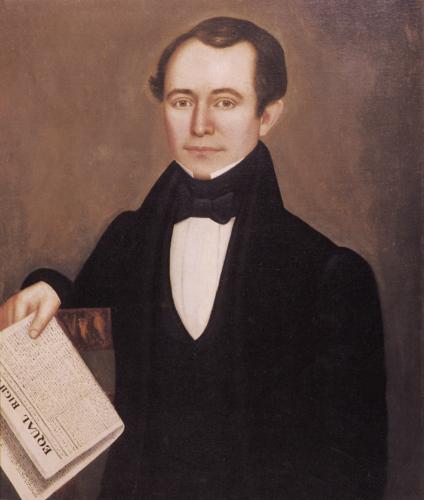Liberty Matters
Leggett and Disunion
 In his contribution to our conversation entitled "How William Leggett Saved Me from the Alt-Right," Anthony Comegna makes a passing reference to "Leggett's disunionist abolitionism." Here I want to underscore Leggett's disunionism, which was quite unusual in its day. Leggett in 1835-37 was one of the earliest abolitionists to propose that the non slaveholding states should exit the Union rather than participate in perpetuating slavery by continuing to make concessions to the slave holding states.
In his contribution to our conversation entitled "How William Leggett Saved Me from the Alt-Right," Anthony Comegna makes a passing reference to "Leggett's disunionist abolitionism." Here I want to underscore Leggett's disunionism, which was quite unusual in its day. Leggett in 1835-37 was one of the earliest abolitionists to propose that the non slaveholding states should exit the Union rather than participate in perpetuating slavery by continuing to make concessions to the slave holding states.Although there had been a small New England disunion movement during the War of 1812, it was only tangentially connected to abolitionism. It was mostly a response to the trade embargo that disproportionately harmed New England . The Hartford Convention of 1814-15 passed a resolution protesting the over representation of slave holding states in Congress that resulted from the notorious constitutional provision counting three-fifths of enslaved residents for purposes of apportionment, but it did not question the institution of slavery.
The most famous disunionist abolitionist before the Civil War was William Lloyd Garrison, who came to prominence in the 1830s. A detailed study of the development of Garrison's thought[62] reports, however, that he did not embrace disunion until around 1842.
Garrison's arguments for disunion, like Leggett's, were normative. Leggett argued that it was wrong to suppress abolitionist speech (censor the mails, allow mobs to violently interrupt rallies) to placate southerners for the sake of preserving the Union. Garrison argued that it was immoral per se to remain in a political union with slave holding states. Other abolitionists added the strategic argument that dissolution of the Union would free northern states from a legal obligation to return fugitive slaves, thereby making escape from slavery much easier (a runaway would need only cross the Mason-Dixon line, not the Canadian border), and put the expense of preventing runaways back on the slave holding states.
Leggett in 1835 was outraged by the suggestion, which he attributed to unnamed southern newspapers, that northern states should prohibit public expressions of abolitionist opinion on threat of southern secession. He attributed the threat to "the arts and intrigues of Calhoun and his followers and myrmidons." Leggett responded:[63]
[I]f we can hope to maintain our fraternal connexion with our brothers of the south only by dismissing all hope of ultimate freedom to the slave; let the compact be dissolved, rather than submit to such dishonourable, such inhuman terms for its preservation. Dear as the Union is to us, and fervently as we desire that time, while it crumbles the false foundations of other governments, may add stability to that of our happy confederation, yet rather, far rather would we see it resolve into its original elements tomorrow, than that its duration should be effected by any measures so fatal to the principles of freedom as those insisted upon by the south.
Leggett was ashamed to see his country's flag fly over slave holding states, reflecting a Constitution that protected the legality of slavery:[64]
We confess, with the keenest mortification and chagrin, that the banner of our country is the emblem, not of justice and freedom, but of oppression; that it is the symbol of a compact which recognizes, in palpable and outrageous contradiction of the great principle of liberty, the right of one man to hold another as property;
He summarized his position in 1837: "We cannot give up Freedom for the sake of Union."[65] Perhaps most radically, contemplating the possibility of a bloody slave revolt in the southern states, Leggett allowed that his sympathies would lie with the enslaved, not with his fellow citizens who were their oppressors:
We earnestly trust that the great contest of opinion which is now going on in this country may terminate in the enfranchisement of the slaves, without recourse to the strife of blood; but should the oppressed bondmen, impatient of the tardy progress of truth urged only in discussion, attempt to burst their chains by a more violent and shorter process, they should never encounter our arm, nor hear our voice, in the ranks of their opponents. We should stand a sad spectator of the conflict; and whatever commiseration we might feel for the discomfiture of the oppressors, we should pray that the battle might end in giving freedom to the oppressed.[66]
Endnotes
[62.] William M. Wiecek, The Sources of Anti-Slavery Constitutionalism in America, 1760-1848 (Ithaca, NY: Cornell University Press, 1977), pp. 236-38.
[63.] "Slavery No Evil," Evening Post (September 9, 1835). <https://oll.libertyfund.org/titles/682#Legett_0012_513>.
[64.] "Abolition Insolence," Plaindealer (July 29, 1837). <https://oll.libertyfund.org/titles/682#Legett_0012_560>.
[65.] "Progress of Fanaticism," Plaindealer (January 14, 1837). <https://oll.libertyfund.org/titles/682#Legett_0012_528>.
[66.] "Abolition Insolence," Plaindealer (July 29, 1837). <https://oll.libertyfund.org/titles/682#Legett_0012_560>.
Copyright and Fair Use Statement
“Liberty Matters” is the copyright of Liberty Fund, Inc. This material is put on line to further the educational goals of Liberty Fund, Inc. These essays and responses may be quoted and otherwise used under “fair use” provisions for educational and academic purposes. To reprint these essays in course booklets requires the prior permission of Liberty Fund, Inc. Please contact oll@libertyfund.org if you have any questions.